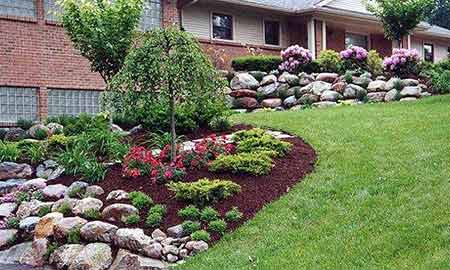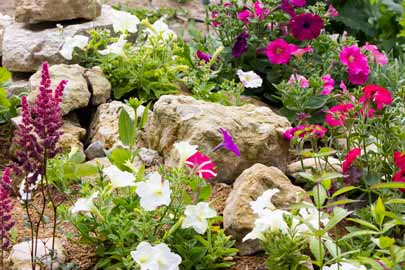Your outdoor creativity knows no bounds and your GreenView lawn is just the beginning. To add depth, texture and interest to your outdoor living spaces, you can choose a variety of materials, including—yes, rocks.
 Hardscaped front yard
Hardscaped front yard
Landscaping with rocks and stone is part of what landscapers call “hardscaping.” Contrasted with the “softscape,” which is composed of living material like your lawn and plantings, the hardscape is the foundation of your design and could include rock accents, rock gardens and even walls, walkways and lawnscaped patios.
Rocks can enhance any area about and around your lawn, or can provide a focal point. The trends in landscaping are moving toward the “spectacular,” as homeowners look for new and exciting ways to make their lawns and outdoor entertainment areas stand out. You can pick up a decorative rock or stone on a nature walk, or visit your local gardening center where you can find a wide variety of choices – including “faux” or synthetic rocks.
 Petunias in a rock garden
Petunias in a rock garden
© Thinkstock
Rock gardens are functional as well as aesthetically pleasing. Rocks placed strategically throughout a garden or on an incline can stop soil erosion and direct water away from unwanted areas. But most important to your rock feature design is the concept of blending. The most attractive rock gardens are those that look natural and blend with the surrounding environment. Use weathered stones native to your area for the best results. Rock gardens should be simple and informal and scaled to fit well within your property bounds. Pools and streams add charm; trees and shrubs add shelter and shade.
It’s easy to get carried away with the size or quantity of rocks you use, so be sure to consider positioning plants so that you can easily remove undesirable weeds, prune plants, or set out new species wherever you choose—without having to climb. Positioning flat stones located near plantings gives you a stepping path for maintaining your garden.
Start at the bottom and work up, placing the rocks so they look like they just naturally fell there. Consider how water will run off and through your garden and tip the stones accordingly. Choose large rocks and anchor them well in the soil. Very small ones may become buried or disappear under moss or plants. Plant hardy native ferns, perennials, miniature roses, and spring-flowering bulbs for a beautiful dotting of color between the rocks. In a rock garden, a natural and wild appearance is more pleasing than an overly planned, overly planted or symmetrical design.
A common mistake rock gardeners make is to plant in shallow soil between the rocks. In fact, your plants will need a good depth of rich soil to thrive between the hardscaping. As a final touch, add compost or shredded peat moss and fertilize with Natural Start by GreenView All Purpose Plant Food.